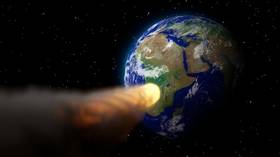An asteroid just made the closest fly-by of Earth ever recorded… and nobody saw it coming

A car-sized asteroid just skimmed past Earth in the closest space rock fly-by ever recorded. And none of our planetary defense systems saw it coming until it had already passed by.
Asteroid 2020QG whizzed past Earth at a distance of less than 3,000 kilometers, meaning it came closer than the vast majority of commercial satellites that orbit Earth. The remarkably close shave means the space rock jumps straight to the top of Earth’s close calls with asteroids. This is despite the database stretching back over 100 years.
Astronomers at the Palomar Observatory in California first spotted the asteroid six hours after it flew by Earth. Observations suggest the space rock came closest to Earth when it flew over the Southern Hemisphere just after 4am Universal Time on Sunday.
Newly-discovered asteroid ZTF0DxQ passed less than 1/4 Earth diameter yesterday, making it the closest-known flyby that didn't hit our planet.@renerphoSimulation: https://t.co/a81R100OwVHigher-res GIF: https://t.co/4Wxn0YNpVbpic.twitter.com/SMtVRbjYOA
— Tony Dunn (@tony873004) August 17, 2020
Experts say 2020QG posed little risk to Earth as it would likely have been almost entirely burned up by the atmosphere had it been on a collision course with our planet.
However, it again highlights the importance of asteroid detection systems and that our planetary defenses need to be bolstered, in case more serious threats stray into Earth’s path in the future.
A stark example of this is the undetected Chelyabinsk meteor which exploded above Russia in February 2013. The comet was just 18 meters in diameter, but was still sizable enough to cause significant localized damage including blowing out thousands of windows.
Another example came in December 2018 when an undetected asteroid that was 10 times more powerful than the bombs dropped on Hiroshima and Nagasaki broke apart over the Bering Sea.
Also on rt.com Planetary defenses reinforced by new laser array that can spot ‘invisible’ space debris in broad daylightLike this story? Share it with a friend!














